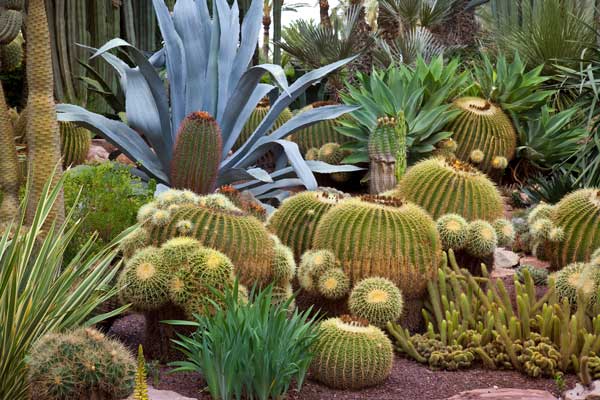Remember those captivating desert landscapes from movies, dotted with spiky silhouettes? Cacti, with their otherworldly charm and surprising resilience, have captivated hearts for centuries. Now, you can bring that very magic into your own home garden!
But cacti offer more than just captivating aesthetics. As a busy individual or someone just starting your plant parenthood journey, you’ll appreciate their minimal maintenance needs. But here’s what really sets them apart: speed.
Fast-growing cacti are the perfect solution for adding instant visual impact and unique character to your space. They grow several inches per year, compared to other cacti that take years to reach maturity. This means you can witness their transformation and enjoy their spiky presence sooner.
Before we delve into the vibrant world of fast-growing cacti, let’s clarify the term “fast-growing” in this context. Unlike fast-growing vegetables that mature within weeks, we’re measuring inches per year. This means you can expect to see noticeable growth compared to slower-growing cacti, allowing you to witness the magic unfold quicker.
To help you navigate this exciting realm, we’ve categorized these spiky speedsters into four distinct groups, each highlighting a unique characteristic:
Category 1: Show-Stopping Spines
Golden Barrel Cactus (Echinocactus grusonii)
Scientific name Kroenleinia grusonii
Common name Golden barrel cactus, golden ball, mother-in-law’s cushion
Growing zones USDA hardiness zones 9a to 11b
Maximum size Can reach over 1 meter (3.3 feet) in height and 40 to 80 centimeters (15.7 to 31.5 inches) in diameter after many years
Sunlight requirements Requires full sunlight
Soil preference Well-draining soil
Soil pH Prefers slightly acidic to neutral soil pH (6.1 to 7.5)
Water needs Low water needs; requires watering sparingly, especially in winter
Blooming period Small yellow flowers appear in summer around the crown of the plant, typically after twenty years or more. The flowers last for about 3 days.
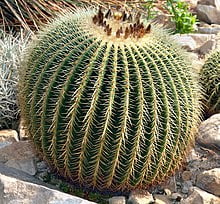
The Golden Barrel Cactus isn’t just another cactus; it’s a show-stopping centerpiece waiting to transform your home garden. This iconic cactus, native to Mexico, boasts a crown of golden spines and a globular shape, adding a touch of drama and visual interest to any space.
Intriguing Features:
- Show-stopping spines:As the name suggests, the Golden Barrel Cactus is adorned with long, straight, or slightly curved spines in shades of yellow or white. These spines, arranged in a captivating radial and central pattern, give the cactus its distinctive crown-like appearance.
- Imposing size:This impressive cactus can reach over 1 meter in height and 40 to 80 centimeters in diameter, making a bold statement in your garden.
- Blooming beauty:Mature Golden Barrel Cacti surprise you with small yellow flowers in the summer, adding a touch of delicate charm to their spiky exterior.
Beyond the Beauty:
While captivating with its aesthetics, the Golden Barrel Cactus also holds a conservation significance. It is listed as endangered on the IUCN Red List due to habitat loss. By choosing to cultivate this unique cactus, you can become a responsible plant parent, contributing to raising awareness about its vulnerable status.
2- Pencil Cactus (Euphorbia tirucalli)
Scientific name Euphorbia tirucalli
Common name Indian tree spurge, naked lady, pencil tree, pencil cactus, fire stick, aveloz, milk bush
Growing zones Semi-arid tropical climates, also introduced to tropical regions
Maximum size Up to 7 meters (23 feet) in height
Sunlight requirements Prefers full sun
Soil preference Thrives in black clay soils, adaptable to various soil types
Soil pH Tolerant of a wide range of soil pH levels
Water needs Drought tolerant, prefers dry conditions
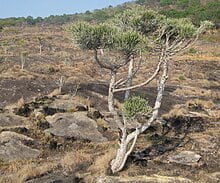
The Euphorbia tirucalli, often shrouded in a multitude of nicknames like Indian tree spurge, pencil cactus, or milk bush, is a fascinating plant that defies easy categorization. It’s not quite a cactus, yet thrives in arid environments. It’s not entirely a tree, but can reach impressive heights. This adaptable wonder from Africa offers a unique blend of visual intrigue and practical applications, making it a conversation starter in any garden.
Aesthetics with an Edge:
- Pencil-perfect branches:The Euphorbia tirucalli’s most striking feature is its forest of green, pencil-thick branches. These smooth, succulent stems add a sculptural element and a touch of the unexpected to your garden.
- A touch of sunshine:While not the showiest bloomer, the Euphorbia tirucalli produces bright yellow flowers at the tips of its branches, adding a burst of color during its flowering season.
A Word of Caution:
It’s important to note that the Euphorbia tirucalli contains a milky sap that is toxic and corrosive. Always handle the plant with care and ensure proper precautions are taken, especially around children and pets.
3- Cereus Forbesii (Cereus forbesii):
Scientific name Cereus forbesii
Common name Cereus forbesii
Maximum size Can grow up to 3 m (9 ft 10 in) in height, 7 in).
Sunlight requirements Full-sun
Soil preference Well-draining soil is preferred.
Soil pH Prefers slightly acidic to neutral soil pH.
Water needs Low water needs, adapted to arid conditions.
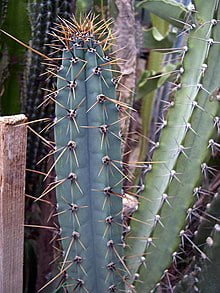
There’s a reason the Cereus forbesii isn’t your average houseplant. This columnar cactus, hailing from the rugged landscapes of Bolivia and Argentina, is a testament to endurance and adaptation. While it may not be the cuddliest addition to your garden, its resilience and unique characteristics make it a fascinating choice for those seeking a touch of the extraordinary.
Built to Withstand:
- A tower of strength:The Cereus forbesii can reach an impressive 3 meters (nearly 10 feet) in height, standing tall and proud in your garden. Its branching, colony-forming nature allows it to create a captivating cluster, adding a touch of vertical interest.
- Enduring extremes:This cactus thrives in harsh environments. Imagine surviving scorching sun by day and near-freezing temperatures by night! The Cereus forbesii isn’t just surviving, it’s flourishing in these extremes, showcasing its remarkable adaptability.
Aesthetics with a Twist:
While not boasting the most flamboyant flowers, the Cereus forbesii offers a subtle elegance. Here’s a peek at its visual appeal:
- Subtlety in shades:The cactus starts out a cool blue-green, maturing to a lighter green. This color palette adds a touch of tranquility to your garden.
- A touch of bloom:The plant produces white to reddish flowers with pink petals and a yellow center, offering a delicate contrast to its spiky exterior.
4- Hedgehog Cactus (Echinopsis mamillata)
Genus: Echinocereus
Growing Zones: 5-10
Maximum Size: Varies, typically 1-3 feet tall
Sunlight Requirements: Full sun to partial shade
Soil Preference: Well-draining, sandy or rocky
Soil pH: 6.0-7.0
Water Needs: Low
Blooming Period: Spring to summer
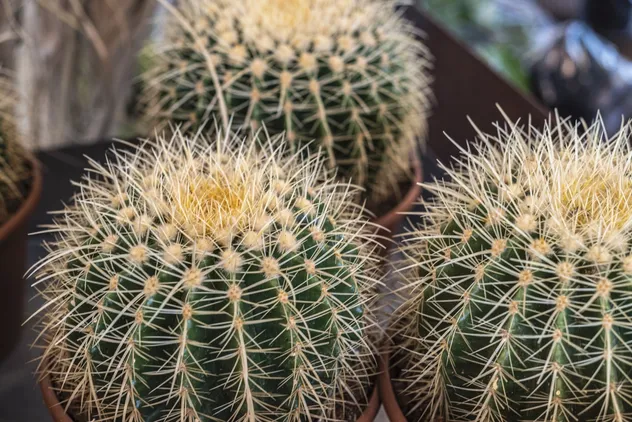
Don’t let the name fool you, the Hedgehog Cactus (Echinocereus) isn’t just another prickly adversary in your garden. This diverse group of over 60 species, hailing from Central Mexico and the western United States, offers a variety of visual intrigue and surprising versatility.
A Plethora of Personalities:
- Cylindrical charm:Imagine a cluster of soft-bodied, cylindrical cacti, each adorned with spine-bearing tubercles forming unique ribbed patterns. This is the quintessential characteristic of the Hedgehog Cactus, adding a touch of sculptural interest to your garden.
- A spectrum of blooms:While individual species may vary, Hedgehog Cacti often surprise you with large flowers in shades of red, yellow, and green, adding a burst of color during their blooming season.
5. Fishbone Cactus
| Scientific Name | Epiphyllum anguliger (formerly Disocactus anguliger) |
|---|---|
| Common Name | Fishbone Cactus, Ric-Rac Cactus, Orchid Cactus |
| Growing Zones | USDA Zones 10-11 |
| Maximum Size | Can reach up to 3 feet (0.9 meters) in length |
| Sunlight Requirements | Bright, indirect light |
| Soil Preference | Well-draining potting mix |
| Soil pH | Slightly acidic to neutral (pH 6.0-7.0) |
| Water Needs | Moderate; water when top inch or two of soil is dry |
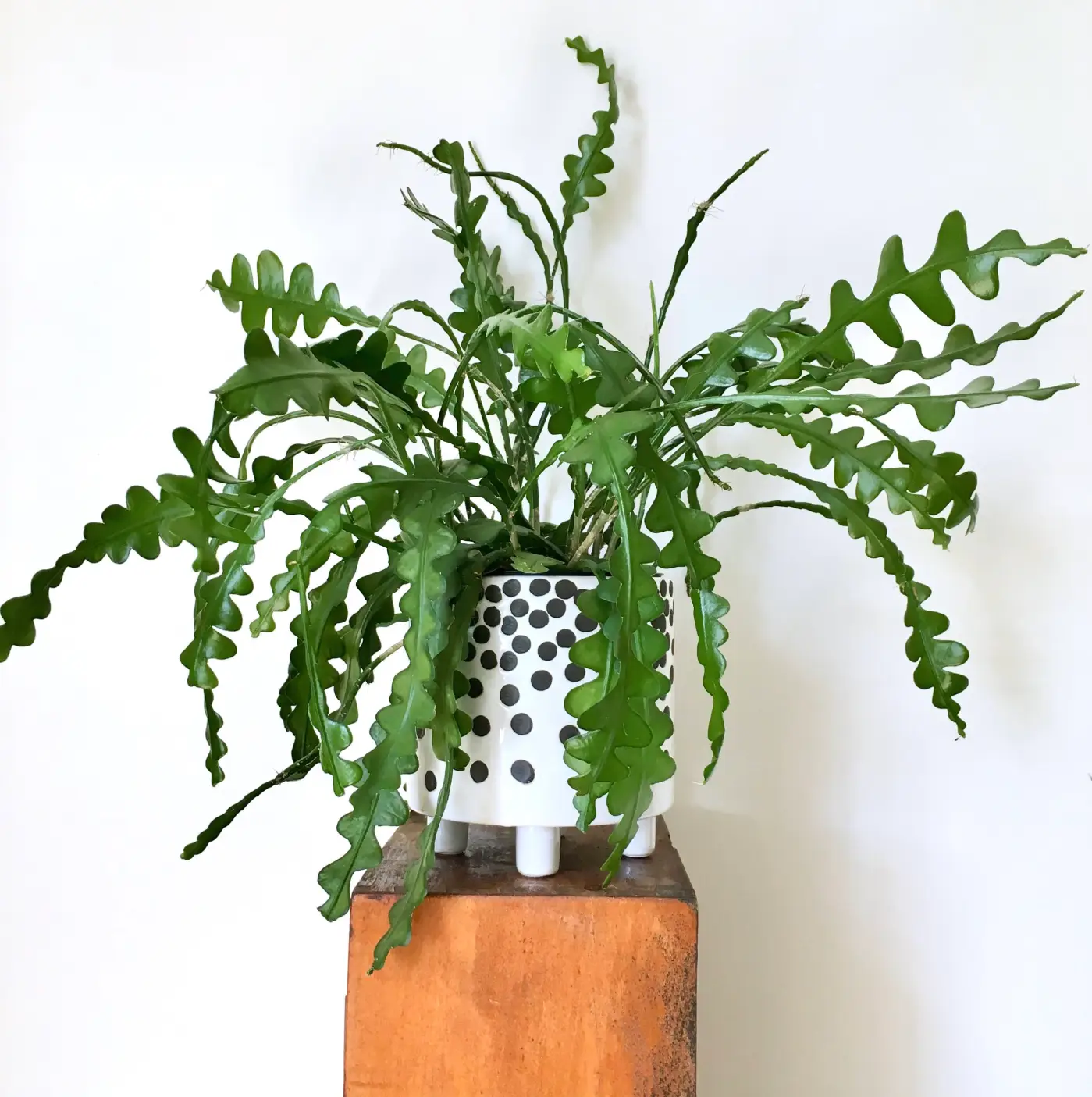
Unfurl the beauty of the fishbone cactus (Epiphyllum anguliger or Selenicereus anthonyanus), a captivating succulent native to the lush rainforests of Mexico. This houseplant is a true conversation starter, prized for its unique appearance and surprisingly low-maintenance nature.
A Standout in the Plant World:
- Fishbone fascination: Its defining feature lies in its flattened stems, resembling the intricate bones of a fish. This unique structure, earning it nicknames like ric rac cactus or zig zag cactus, adds a touch of whimsy to any indoor space.
- Blooming sporadically: While not a constant display, the fishbone cactus occasionally surprises with stunning orchid-like flowers, further enhancing its exotic appeal.
Thriving Indoors:
Bringing a touch of the tropics indoors is easy with the fishbone cactus:
- Warm welcome: Mimic its rainforest origins by providing a warm and humid environment. Protect it from frost and harsh temperature fluctuations.
- Indirect light matters: While it enjoys the dappled sunlight of the rainforest floor, avoid harsh direct sunlight indoors. Opt for bright, indirect light.
- Moisture magic: Replicate the rainforest humidity by keeping the soil moist but not soggy. A potting mix of compost and cactus-specific soil provides both drainage and moisture retention. Repotting every 3 to 4 years ensures ample space for healthy root growth.
Category 2: Blooming Beauties
6- Easter Cactus (Hatiora gaertneri)
Scientific name Rhipsalidopsis gaertneri
Common name Easter cactus or Whitsun cactus
Growing zones USDA zones 10-11
Maximum size Branching pendant shrub, typically up to 30 cm (12 in) in height
Sunlight requirements Half-shade recommended; can tolerate some direct sunlight but prefers filtered light
Soil preference Well-draining soil, preferably slightly acidic
Soil pH Slightly acidic (around pH 5.5-6.5)
Water needs Requires continuously moist soil; avoid overwatering or underwatering
Blooming period Late Spring in the Northern Hemisphere
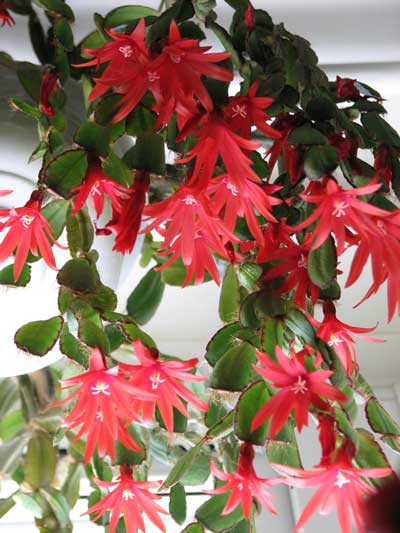
The Easter Cactus (Hipsalidopsis gaertneri), also known as the Whitsun Cactus, isn’t your typical desert dweller. This captivating plant thrives in the lush embrace of subtropical rainforests, offering a unique blend of elegance and vibrant blooms.
A Rainforest Resident:
- Hidden in the canopy:Unlike its desert counterparts, the Easter Cactus isn’t rooted in soil; it’s epiphytic. This means it grows on trees in the rainforests of southeastern Brazil, specifically at altitudes ranging from 350 to 1,300 meters.
- Pendant perfection:As it matures, the Easter Cactus develops into a branching, pendant shrub with a woody base. Its cascading form adds a touch of vertical interest and a touch of the unexpected to any indoor space.
Beauty Beyond the Green:
- Unique foliage:This cactus boasts flattened segments called cladodes, which act as its leaves. These segments start out a dullish green, adding a touch of lushness to your surroundings.
- A burst of scarlet:The true showstopper is the Easter Cactus’s vibrant blooms. These scarlet flowers are radially symmetrical and open into a funnel shape, offering a burst of color during the spring and summer months.
7. Queen of the Night (Epiphyllum oxypetalum)
Scientific name Epiphyllum oxypetalum
Common name Dutchman’s pipe cactus, Queen of the Night
Growing zones USDA zones 10-11
Maximum size Up to 6 meters (20 feet) in length for primary stems; secondary stems up to 30 cm x 12 cm (12 in x 5 in)
Sunlight requirements Partial shade to full shade
Soil preference Well-draining, organic-rich soil
Soil pH Slightly acidic to neutral (pH 6.0-7.0)
Water needs Moderate, water thoroughly but allow soil to dry out between waterings
Blooming period Late spring through late summer, flowers bloom nocturnally and wilt before dawn
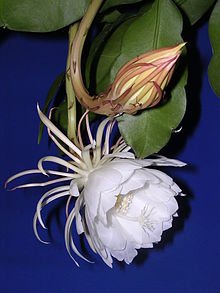
Earning its Spiky Name:
The name “Echinopsis” originates from the Greek words “echinos,” meaning hedgehog or sea urchin, and “opsis,” meaning appearance. This aptly describes the dense covering of spines that characterizes these cacti, resembling the spiky exterior of their namesakes.
A Spectrum of Sizes and Shapes:
The Echinopsis genus boasts a remarkable diversity in its physical form. From large, tree-like giants reaching several meters in height to small, globose cacti that fit comfortably in the palm of your hand, there’s an Echinopsis to suit every preference.
Blooming Marvels:
Echinopsis are renowned for their show-stopping blooms. These large, trumpet-shaped flowers come in a variety of vibrant colors, including white, pink, yellow, and even red. They typically bloom at night, releasing a sweet fragrance that fills the air.
8. Christmas Cactus (Schlumbergera bridgesii)
Scientific name Schlumbergera bridgesii
Common name Christmas Cactus
Growing zones Suitable for indoor growth; specific outdoor zones not specified
Maximum size Height: 10 in/25.4 cm, Diameter: 24 in/61 cm
Sunlight requirements Full, direct sunlight during late fall and winter; partial sun conditions at other times of the year
Soil preference Well-draining soil mix, consisting of 60% potting soil with pH-balanced formula and 40% bark or perlite
Soil pH Not specified, but soil should be pH-balanced as mentioned above
Water needs Keep the top inch of soil moist; avoid water-logging; water less during resting period from Feb – March
Blooming period Mid-November to January

The Christmas Cactus (Schlumbergera bridgesii), despite its festive name, is a tropical surprise. This unique cactus, hailing from Brazil, offers a vibrant splash of color and intriguing care requirements, making it more than just a seasonal decoration.
Not Your Typical Cactus:
- Shade seeker:Unlike its desert-dwelling cousins, the Christmas Cactus thrives in indirect sunlight, making it perfectly suited for indoor spaces where it can add a touch of the tropics.
- Moisture lover:While most cacti enjoy dry soil, the Christmas Cactus prefers moist, well-draining soil. This creates a unique care routine compared to traditional cacti.
A Festive Flair:
The true magic of the Christmas Cactus lies in its spectacular blooms:
- Blooming beauty:From mid-November to January, the Christmas Cactus bursts into bloom, showcasing unique, tube-shaped, double flowers in vibrant shades of pink. These blooms are further accentuated by neon pink pollen-bearing stamens, adding a touch of festive cheer.
- Blooming secrets:Extend the bloom period by maintaining temperatures around 68°F (20°C) and induce next year’s blooms by providing 12-14 hours of darkness during fall nights.
Care Beyond the Holidays:
The Christmas Cactus thrives with specific care:
- Temperature matters:Maintain temperatures above 50°F (10°C) to prevent bud drop, ensuring the development of those beautiful blooms.
- Seasonal cycles:The plant requires a resting period from February to March and a pre-flowering dry period from October to November. Understanding these cycles is crucial for optimal growth and flowering.
9. Rebutia
Scientific name Rebutia
Common name Rebutia cacti
Growing zones USDA zones 9-11
Maximum size Typically small, globular form
Sunlight requirements Full sun to partial shade
Soil preference Well-draining soil, preferably sandy or gritty
Soil pH Slightly acidic to neutral (pH 6.0-7.0)
Water needs Moderate; water sparingly, allowing soil to dry out between waterings
Blooming period Typically in spring or early summer, but can vary depending on species and growing conditions
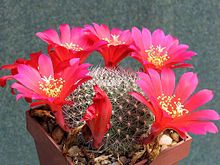
The Rebutia genus, native to the landscapes of Bolivia and Argentina, captivates with its small, colorful cacti. While their showstopping blooms might be the first thing to catch your eye, these unique plants hold more than meets the eye.
A World of Miniatures:
- Compact and charming:Rebutia cacti are known for their small size and globular form. This makes them ideal for indoor gardens or miniature gardens, adding a touch of whimsy to any space.
- Blooming beyond their size:Despite their small stature, Rebutia boasts relatively large, colorful flowers. These vibrant blooms come in various shades, adding a burst of color that belies their compact size.
Beyond the Surface:
A closer look reveals the unique characteristics of Rebutia:
- Smooth operators:Unlike their ribbed counterparts, Rebutia cacti lack distinctive ribs. Instead, they have regularly arranged small tubercles, creating a smooth, textured appearance.
- Easy on the eyes, easy to grow:Rebutia are generally considered easy to grow, making them perfect for both experienced and beginner plant parents.
- Prolific propagators:These cacti can readily produce large quantities of seeds that germinate freely around the parent plant, allowing you to easily expand your collection or share the joy with others.
10. Moon Cactus (Gymnocalycium mihanovichii)
Scientific name Gymnocalycium mihanovichii
Common name Moon Cactus
Growing zones Zone 10a (Minimum 30°F
Sunlight requirements Partial sun to partial shade
Soil preference Well-draining soil mix
Water needs Typical for succulents, “soak and dry” method
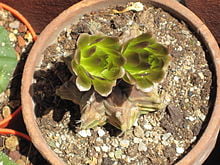
The Moon Cactus (Gymnocalycium mihanovichii) isn’t your typical cactus. This vibrantly colored wonder is a fascinating example of grafting, a horticultural technique that combines two different cacti to create a unique plant.
A Match Made, Not Born:
- Crafted, not born:Unlike most cacti, the Moon Cactus isn’t a single plant but a combination of two. The colorful, mutant scion (Gymnocalycium) is grafted onto a rootstock cactus (typically Hylocereus). This grafting allows the scion to survive despite its inability to photosynthesize due to its mutated form.
- A delicate balance:The Moon Cactus thrives in partial sun to partial shade and requires moderate watering, following the “soak and dry” method. This balance ensures both the scion and rootstock receive the right conditions.
A Burst of Color, a Touch of Whimsy:
- Compact and captivating:The Moon Cactus typically grows up to 12 inches tall, making it a charming addition to desks, windowsills, or small gardens.
- A vibrant explosion:While not cold hardy and requiring indoor living in most climates, the Moon Cactus brings a pop of color with its vibrant hues. These come from the mutant scion, available in various shades like red, yellow, orange, and even pink.
Category 3: Compact & Colorful
11. Crown of Thorns (Euphorbia milii)
Scientific name Euphorbia milii
Common name Crown of thorns, Christ plant
Growing zones Not hardy, best in warmer climates
Maximum size Up to 1.8 meters (5 ft 11 in) tall
Sunlight requirements Full sun, tolerates partial shade
Soil preference Well-draining soil
Soil pH Neutral to slightly acidic (pH 6.0-7.0)
Water needs Moderate, avoid overwatering
Blooming period Year-round, with peak in spring and summer
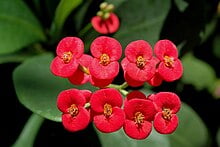
The Euphorbia milii, also known as the crown of thorns or Christ plant, transcends its symbolic moniker. This captivating succulent, hailing from the shores of Madagascar, boasts a rich history and diverse uses.
From Island Origins to Global Reach:
- Island native:Euphorbia milii finds its roots in Madagascar, an island nation renowned for its unique biodiversity.
- A historical introduction:While native to Madagascar, the plant’s journey to other parts of the world is linked to Baron Milius, who introduced it to France in 1821.
A Spiny Beauty:
- Shrubby splendor:As it matures, Euphorbia milii transforms into a woody succulent subshrub or shrub, reaching heights of up to 8 meters. Its densely spiny stems add a touch of intrigue to its overall appearance.
- Beyond the green:While the foliage offers a lush presence, the true showstopper lies in the blooms. Euphorbia milii produces small flowers surrounded by conspicuous bracts in vibrant shades of red, pink, or white.
A Word of Caution:
It’s important to remember that while Euphorbia milii offers a captivating presence, its sap can be harmful. Exercise caution and avoid direct contact, especially for those with sensitive skin or around pets.
12. Living Rock (Lithops dorstenii):
Scientific Name Lithops
Common Name Living Stones
Growing Zones Suitable for arid regions; typically zones 9-11
Sunlight Requirements Full sun to partial shade
Soil Preference Well-draining succulent potting soil
Soil pH Neutral to slightly acidic (pH 6.0-7.0)
Water Needs Drought-tolerant; allow soil to dry completely between waterings
Delve into the world of the Lithops, also known as the “living stone”, and discover a plant that perfectly blends intrigue with ease of care. Native to the arid regions of South Africa, the Lithops has captivated succulent enthusiasts with its unique appearance and minimal maintenance needs.
A Master of Camouflage:
- Nature’s disguise:The Lithops’ most striking feature is its uncanny resemblance to pebbles or small stones. This natural camouflage allows it to blend seamlessly into its rocky habitat, offering protection from predators.
- A minimalist masterpiece:Each Lithops typically boasts two fleshy leaves, often in shades of green, brown, or grey, arranged in a symmetrical, circular pattern. This simplicity adds to its unique charm and visual intrigue.
A Delight for Plant Parents:
Beyond its captivating looks, the Lithops is a dream come true for plant enthusiasts:
- Effortless elegance:This succulent thrives in both sunny and low-light conditions, making it adaptable to various indoor settings.
- Drought champion:Its drought-tolerant nature requires infrequent watering with well-draining soil to prevent rot. This characteristic makes it perfect for busy individuals or those prone to overwatering.
13. Brain Cactus (Echinopsis mamillata ‘Monstrose’):
Scientific Name Mammillaria elongata f. cristata
Common Name Brain Cactus
Growing Zones Not specified (likely zones 9-11)
Maximum Size Height: 15cm; Width: Clusters to around 15cm
Sunlight Requirements Full sun to part shade
Soil Preference Well-drained gritty soil
Soil pH Not specified
Water Needs Water only when dry in warmer months, sparingly in winter
Blooming Period Spring, summer
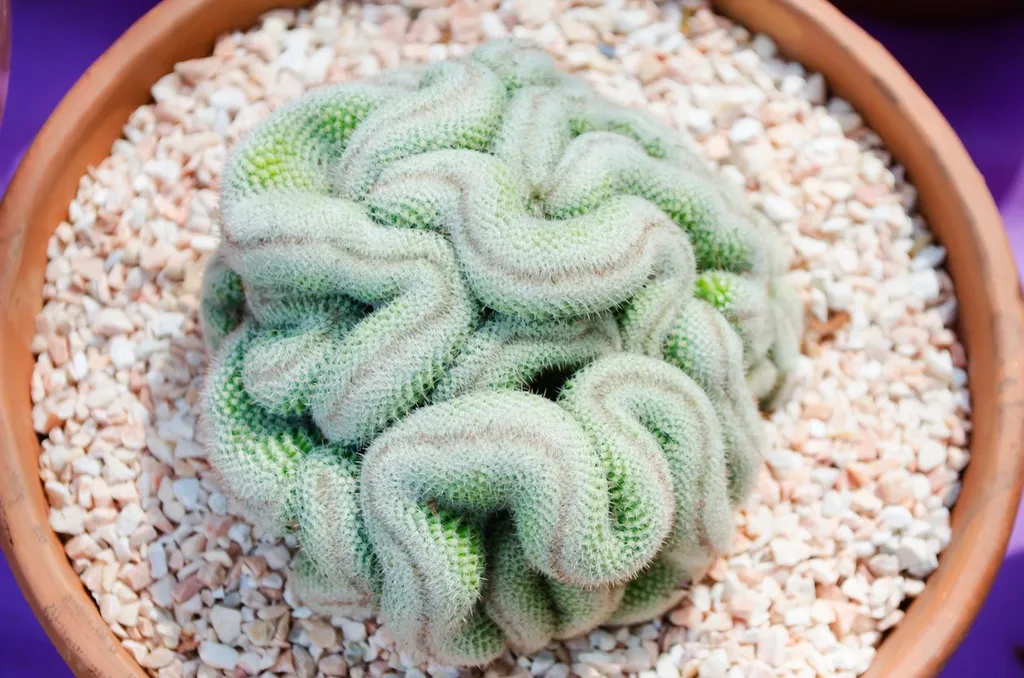
Behold the Mammillaria elongata f. cristata, also known as the Brain Cactus. This captivating cactus isn’t your average desert dweller; it boasts a unique, crested growth pattern that resembles the folds of a human brain, making it a true conversation starter.
A Sculpted Wonder:
- Twisting intrigue:Unlike its typical counterparts, the Brain Cactus features twisting, undulating patterns on its gray-blue to gray-green stems. This crested growth adds a touch of whimsy and visual interest to any space.
- Compact and charming:Reaching only around 15cm in both height and width, the Brain Cactus forms clumps and is perfectly suited for desktops, windowsills, or small gardens.
A Safe and Sound Addition to Your Home:
While non-toxic, it’s always recommended to keep plants out of reach of children and pets to avoid any potential harm.
14. Zebra Cactus (Haworthia fasciata)
Scientific name Haworthia Fasciata
Common name Zebra Plant
Growing zones Zones 9 to 11
Maximum size 5 to 8 inches tall
Sunlight requirements Medium to low light indoors; 4 to 6 hours of bright light outdoors (no direct sunlight)
Soil preference Well-draining cactus potting mix, equal parts pumice or perlite, potting soil, and sand
Soil pH Typically prefers slightly acidic to neutral soil (pH 6.0 to 7.0)
Water needs Moderate; water generously when soil is dry to the touch, allow soil to dry out completely between waterings
Blooming period Typically blooms in spring and summer
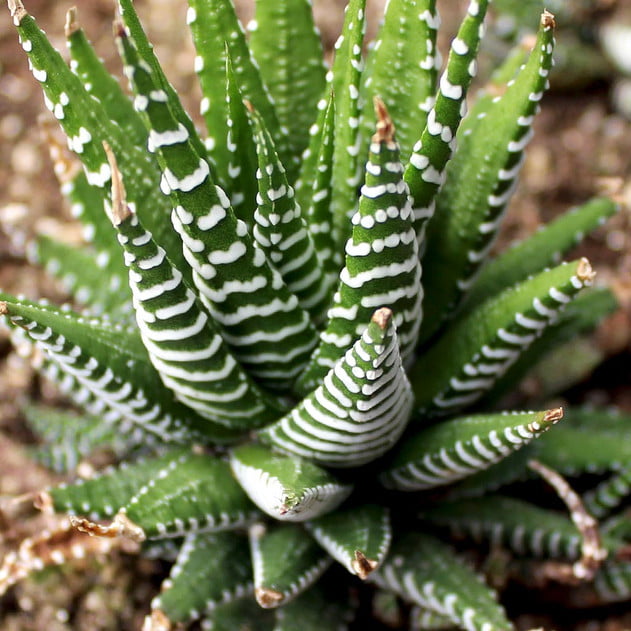
Calling all plant enthusiasts, especially beginners! Look no further than the Zebra Haworthia, a charming succulent that thrives indoors and requires minimal effort to keep it looking its best.
A Tiny Titan of the Plant World:
- Compact and captivating:The Zebra Haworthia boasts a delicate, small size, making it perfect for desks, windowsills, or terrariums. Its thick, dark green leaves adorned with distinctive white tubercles create a striking “zebra” pattern, adding a touch of visual intrigue to any space.
Category 4: Culinary Delights
Important Disclaimer: Before attempting to cultivate or consume any edible cactus, ensure it is legal and safe to do so in your region. Local regulations and laws can vary, so it’s crucial to consult reputable sources and/or qualified professionals for guidance. Additionally, always properly identify any plant before consumption to avoid potentially harmful mistakes.
15. Prickly Pear (Opuntia ficus-indica):
Scientific name Opuntia ficus-indica
Common name Indian fig opuntia
Growing zones Frost-free areas
Maximum size Up to 5 meters in height
Sunlight requirements Full sun
Soil preference Sandy and well-drained
Soil pH Neutral to slightly acidic
Water needs Drought tolerant, but needs some water
Blooming period Early May through early summer in Northern Hemisphere; Fruits ripen from August through October
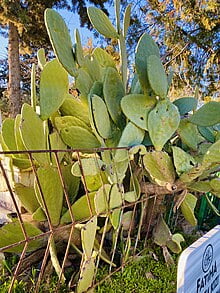
The Opuntia ficus-indica, also known as Indian fig opuntia, fig opuntia, or prickly pear, is more than just a cactus. It’s a versatile and valuable crop cultivated in arid and semiarid regions around the world.
A Plant with Many Gifts:
- A feast for the senses:The prickly pear is primarily grown for its fruit, often described as having a sweet watermelon-like flavor. After removing the outer skin, the fruit can be enjoyed in various ways.
- Beyond the fruit:The plant offers more than just a delicious treat. Its nopales (young stems) are also edible and used in various dishes. Additionally, the prickly pear has various other uses, including:
- Fodder:A valuable food source for livestock.
- Soil conservation:Its extensive root system helps prevent soil erosion, especially in vulnerable arid environments.
Other purposes: The prickly pear also has applications in cosmetics and traditional medicine
16. Dragon Fruit (Hylocereus spp.)
Scientific name Hylocereus spp.
Common name Dragon fruit (DF), Pitaya
Growing zones Tropical and subtropical regions
Maximum size Varies depending on species and variety, typically 25-30 cm in length
Sunlight requirements Full sun
Soil preference Well-draining soil with organic matter
Soil pH Slightly acidic to neutral (pH 6.0-7.0)
Water needs Moderate to low
Blooming period Flowers typically bloom at night, usually from April or May to September or October

- Appearance:This climbing cactus features elongated stems and produces large, vibrant fruits with white flesh and black seeds. The fleshy flesh is the edible part.
- Care:Needs bright, indirect sunlight and prefers consistent moisture (avoid soggy soil). Well-draining potting mix with good aeration is recommended.
17. Peruvian Apple Cactus (Cereus repandus)
Scientific name Cereus repandus
Common name Peruvian apple cactus
Growing zones Suitable for USDA hardiness zones 9b to 11
Maximum size Can grow up to 10 meters (33 feet) in height
Sunlight requirements Requires full sunlight
Soil preference Well-draining soil, preferably sandy or loamy
Soil pH Prefers slightly acidic to neutral soil (pH 6.1 to 7.5)
Water needs Drought-tolerant, minimal watering requirements

The Peruvian apple cactus (Cereus repandus), also known as the giant club cactus or hedge cactus, isn’t your average ornamental plant. This towering wonder, native to South America, boasts a unique combination of impressive size, vibrant blooms, and a hidden culinary treasure.
A Spiny Giant:
- Reaching for the sky:The Peruvian apple cactus can reach staggering heights of 10 meters (33 feet), with some even reaching 110 feet with the help of support. Its cylindrical stems, typically reaching 10-20 cm (4-8 inches) in diameter, stand tall and add a touch of grandeur to any landscape.
- A multitude of names:Known by various names like cadushi (Papiamento and Wayuunaiki) and kayush, this cactus reflects its cultural significance in its diverse appellations.
Beauty in the Night:
Beyond its size, the Peruvian apple cactus offers a breathtaking nocturnal display:
- Night blooming wonder:Cream-colored flowers open after sunset, adding a touch of elegance to the night. This characteristic has earned it the nickname “queen of the night” in some regions.
A Sweet Reward:
While primarily an ornamental plant, the Peruvian apple cactus holds a hidden culinary gem:
- The Peruvian apple:The cactus produces thornless fruits called pitaya or Peruvian apple. These sweet treats are enjoyed by both humans and birds, adding a touch of local flavor to the regions where the cactus thrives.
Common Mistakes to Avoid When Growing Fast-Growing Cactus
While fast-growing cacti offer a unique combination of beauty and ease of care, there are still a few key mistakes to avoid ensuring their continued growth and health:
- Overwatering: This is the most common mistake with cacti, regardless of their growth rate. Remember, cacti are adapted to arid environments and store water in their fleshy stems. Overwatering can lead to root rot, a fungal disease that can be fatal.
- Water only when the soil is completely dry to the touch.Insert your finger at least an inch deep into the soil. If it feels dry, it’s time to water.
- Avoid frequent light watering.This encourages shallow root growth and increases the risk of overwatering. Instead, water deeply and allow the water to drain completely from the drainage holes before placing the pot back on its saucer.
- Improper drainage: Ensure your cactus pot has drainage holes at the bottom to allow excess water to escape. Sitting water around the roots can lead to root rot, as mentioned above.
- Choose pots made from porous materialslike terracotta, which allow for better air circulation and prevent waterlogging.
- Avoid using decorative pots without drainage holes unless you plan to use a liner with drainage holes inside.
- Insufficient sunlight: Fast-growing cacti still need plenty of sunlight to thrive.
- Most fast-growing cacti need at least 6-8 hours of bright, indirect sunlightper day. Avoid harsh midday sun, especially in hot climates, which can scorch the cactus.
- If your home receives limited natural light, consider supplementing with grow lightsspecifically designed for cacti.
- Neglecting soil quality: Cacti require well-draining soil that allows for proper drainage and aeration. Using regular potting mix can retain too much moisture and suffocate the roots.
- Use a cactus mixspecifically formulated for cacti and succulents. These mixes typically contain ingredients like perlite, pumice, or sand, which improve drainage and aeration.
- You can also create your own cactus mix by combining potting mix with perlite or pumice in a ratio of 1:1 (equal parts).
- Not repotting: As your fast-growing cactus matures, it will outgrow its pot.
- Repot your cactus every 1-2 yearsinto a pot that is 1-2 inches larger in diameter than the previous one.
- Repotting in spring or early summer is generally considered the best time.
- Not fertilizing: While cacti don’t need frequent fertilization, providing them with a light feeding occasionally can encourage healthy growth.
- Use a balanced, diluted fertilizerspecifically formulated for cacti and succulents.
- Fertilize only during the active growing season(typically spring and summer) and follow the instructions on the fertilizer label.
By avoiding these common mistakes and following proper care guidelines, you can ensure your fast-growing cacti thrive and add their unique charm to your home garden for years to come!
. Conclusion: Embrace the Spiky Charm of Your Desert Oasis
Fast-growing cacti offer a unique combination of low maintenance and rapid visual impact, making them ideal for busy individuals or those new to the plant parenthood journey. They can transform your home garden into a thriving desert oasis, adding:
- Visual interest:Their diverse shapes, sizes, and textures, along with their impressive spines or vibrant blooms, create a captivating and unique aesthetic.
- Low maintenance:They require minimal watering and infrequent attention, making them perfect for those with limited time or experience.
- Fast growth:Compared to slower-growing cacti, you can witness their transformation and enjoy their presence sooner.
With so many diverse options available, there’s a perfect fast-growing cactus for every space and preference. Explore the categories we’ve presented – Show-Stopping Spines, Blooming Beauties, Compact & Colorful, and Culinary Delights (remembering local regulations and responsible consumption) – to discover your ideal spiky companions.
To delve deeper into the fascinating world of cacti and learn more about their care and cultivation, here are some resources:
- The National Cactus and Succulent Society:https://cactusandsucculentsociety.org/
- The International Organization for Succulent Plant Study:https://succulentresearch.org/
For further exploration of gardening articles, kindly visit our webpage: Home Garden
17 Fastest Growing Cactus Species for Your Thriving Garden
Poa Annua vs Crabgrass Invaders in Your Lawn (Identification & Control Guide)
Red Creeping Thyme Texas Tough & Fragrant Groundcover (Fast-Growing!)
7 Plants That Look Like Foxglove – Toxic + Safe Look Alike
Zinnia Companion Plants: Attract Pollinators For a Thriving Garden
ABOUT THE AUTHOR
M. Waseem Khalid is a respected product reviewer at Home Garden Glow. He has a strong educational background, including an MBA in Marketing and a Post graduate Diploma in Information Technology. With many years of experience, Waseem has become well-known for his expertise in analyzing and critiquing products. He combines his deep understanding of marketing with the latest technological insights to provide valuable reviews.

